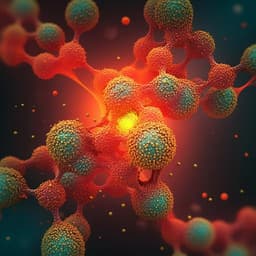
Biology
Machine learning for cluster analysis of localization microscopy data
D. J. Williamson, G. L. Burn, et al.
Unlock the secrets of molecular clustering with this groundbreaking research by David J. Williamson and colleagues. They introduce a fast, supervised machine-learning method that accurately classifies millions of points from single-molecule localization microscopy data, paving the way for new insights in cell biology.
Playback language: English
Introduction
Analyzing single-molecule localization microscopy (SMLM) data, which consists of a list of coordinates representing point emitters, presents a significant challenge. Traditional methods like Ripley's K Function, Getis & Franklin's local point pattern analysis, radial distribution functions, and DBSCAN, often rely on parameter selection that can lead to suboptimal interpretation, especially with complex biological samples and heterogeneous clustering. These methods also frequently necessitate threshold settings to label points as 'clustered' or 'not clustered', a process sensitive to point density and arrangement, making consistent application challenging. While model-based cluster analysis, such as Bayesian inference, offers a solution by scoring against a clustering model, its computational intensity limits its applicability to large datasets. Machine learning provides a powerful alternative to overcome these limitations. This study leverages supervised machine learning, using neural networks, to extract meaningful information from SMLM data by identifying patterns in nearest-neighbor distances, avoiding the need for image rasterization and subjective parameter choices. This approach is applicable to various SMLM techniques like (F-)PALM, (d)STORM, GSD(IM), and (DNA-)PAINT, though it doesn't correct for inherent artifacts of these methods; such corrections should be performed beforehand. The developed software comprises modules for data preparation, model training, evaluation, and cluster property description, offering a fast and accurate solution for large-scale SMLM data analysis.
Literature Review
The paper reviews existing computational approaches for analyzing the spatial clustering in single-molecule localization microscopy data. It highlights the limitations of traditional methods such as Ripley's K function, Getis & Franklin's local point pattern analysis, radial distribution functions, and DBSCAN. These methods are criticized for their reliance on user-defined parameters, sensitivity to sample heterogeneity, and computational limitations when dealing with large datasets. Model-based approaches, like Bayesian inference, are mentioned as an improvement but are also noted for their computational intensiveness. The authors argue that machine learning offers a suitable alternative due to its ability to extract meaningful information from complex data without relying on fully descriptive models or subjective parameter choices. The application of machine learning to microscopy images, typically using convolutional neural networks for raster-based images, is briefly discussed, highlighting the incompatibility of these networks with the coordinate-based nature of SMLM data. The use of nearest-neighbor distances as input features for machine learning models is justified.
Methodology
The proposed method uses a supervised machine-learning approach with neural networks to classify points in SMLM data as either 'clustered' or 'not clustered'. The input to each model is an array of values derived from each point's nearest-neighbor distances. Three different neural network models were developed using Keras, an open-source machine-learning framework: XPILJZ (a simple model with two fully connected layers), 07VEJJ (a more complex model incorporating convolutional, max pooling, dropout, and LSTM layers to exploit correlations and reduce overfitting), and 87B144 (similar to 07VEJJ but with a larger input layer to handle denser clusters). The models were trained on simulated clustered data representing various clustering scenarios, generated by distributing points within 'cell-like' shapes mimicking T-cell synapses. The simulated data varied in parameters such as overall point density, points per cluster, proportion of clustered points, and maximum distance from the cluster center. The nearest-neighbor distances for all points in the simulated datasets were calculated and used as input for training. The data was split into training, validation, and testing sets. Model performance was evaluated using metrics such as accuracy and F1 score. After classification, a clustering algorithm was employed to group clustered points into clusters, and cluster shapes were defined based on the mean nearest-neighbor distance. The performance of the developed models was compared with existing methods like Getis & Franklin's local point pattern analysis (G&F LPPA), Bayesian cluster analysis, DBSCAN, and SR-Tesseler. The computational efficiency of each method was also compared. The impact of the number of nearest neighbors used as input and the type of input data (Euclidean distances vs. normalized coordinates) on model performance was investigated. The methodology also included experiments testing the models' ability to handle clusters exceeding the input window size and clusters with Gaussian point distributions. Finally, the potential for extending the model to three dimensions and incorporating multiple labels (e.g., different cluster shapes) was explored. Experimental data consisted of dSTORM images of Csk and PAG in primary human T cells under different activation conditions. The images were processed using ThunderSTORM for localization and drift correction. The trained models were used to analyze the experimental data, and the resulting cluster statistics were compared between different cell types and activation states.
Key Findings
The developed machine-learning models demonstrated high accuracy in classifying points as clustered or non-clustered in both simulated and experimental SMLM datasets. Model 07VEJJ achieved an accuracy of 92.4% on testing data, and Model 87B144 achieved 94.0% accuracy, both showcasing superior performance to other evaluated methods. The models accurately classified points across a wide range of simulated clustering scenarios, even those outside of the original training data range, though performance decreased slightly at very low densities. The comparative analysis revealed that the machine learning approach was significantly faster and less parameter-dependent than other methods (Bayesian analysis, DBSCAN, SR-Tesseler and Getis & Franklin's LPPA), especially for large datasets. Analysis of experimental dSTORM data of Csk and PAG in T cells showed changes in clustering patterns dependent on T cell activation status. Specifically, activated T cells demonstrated an increase in Csk clusters with a slight decrease in cluster area, suggesting a redistribution of Csk to different binding partners. Naive T cells showed an increase in both the percentage of points clustering and the number of points per cluster with stimulation. Pre-stimulated T cells demonstrated increased Csk and PAG clustering compared to naive cells, with a decrease in the number of PAG clusters after stimulation. The model's adaptability was demonstrated by successfully analyzing simulated 3D data and data with multiple cluster labels (circular and filamentous clusters). A 3D model (GAXJPR) achieved 97.5% accuracy on testing data. A multi-label model (3TXKFS) successfully identified different cluster types.
Discussion
The findings address the research question by demonstrating the effectiveness of a machine-learning approach for accurate and efficient cluster analysis of SMLM data. The superior performance of the neural network models compared to existing methods highlights the potential of this approach to improve the analysis of complex biological systems. The observed changes in Csk and PAG clustering in T cells provide new insights into the regulation of T-cell receptor signaling, specifically the role of PAG in regulating Csk localization and its dynamic changes upon T-cell activation. The increased accuracy and speed compared to existing methods make this approach a valuable tool for high-throughput analysis of large SMLM datasets. The flexibility of the model allows for future expansions, including handling of multi-dimensional data, integration of additional features, and application to different types of microscopy data.
Conclusion
This study introduces a novel machine-learning-based method (CAML) for efficient and accurate cluster analysis of SMLM data. The method's speed, minimal parameter dependence, and adaptability to different cluster types and dimensions make it a valuable tool for SMLM data analysis. The application to experimental data revealed dynamic changes in protein clustering upon T cell activation, providing biological insights. Future work could involve incorporating more sophisticated features, such as localization precision and angles, improving the model's robustness. Exploring unsupervised learning approaches could further enhance the method's versatility and reduce bias from training data.
Limitations
The models were initially trained on simulated data with simplistic, circular clusters. While they performed well on experimental data with more complex cluster shapes, the potential for bias introduced by the training data should be considered. The model's performance was slightly affected by clusters containing significantly more points than the input window size. The study focuses on the specific application to T cell signaling; testing on broader biological contexts is necessary to further validate the model's generalizability. While the model was shown to work on a 3D example, further testing on larger, more complex 3D datasets is necessary.
Related Publications
Explore these studies to deepen your understanding of the subject.







